GPT4.0+Midjourney绘画+国内大模型 会员永久免费使用!
【 如果你想靠AI翻身,你先需要一个靠谱的工具! 】
一、AVL树的概念
AVL树是一种高度平衡的平衡二叉树,相比于搜索二叉树,它的特点在于左右子树都为AVL树且树的高度差的绝对值不超过1。这里我们会引入一个新的概念叫做平衡因子。平衡因子也就是左右子树的高度差,我们可以通过平衡因子方便我们后续去观察和控制树是否平衡。
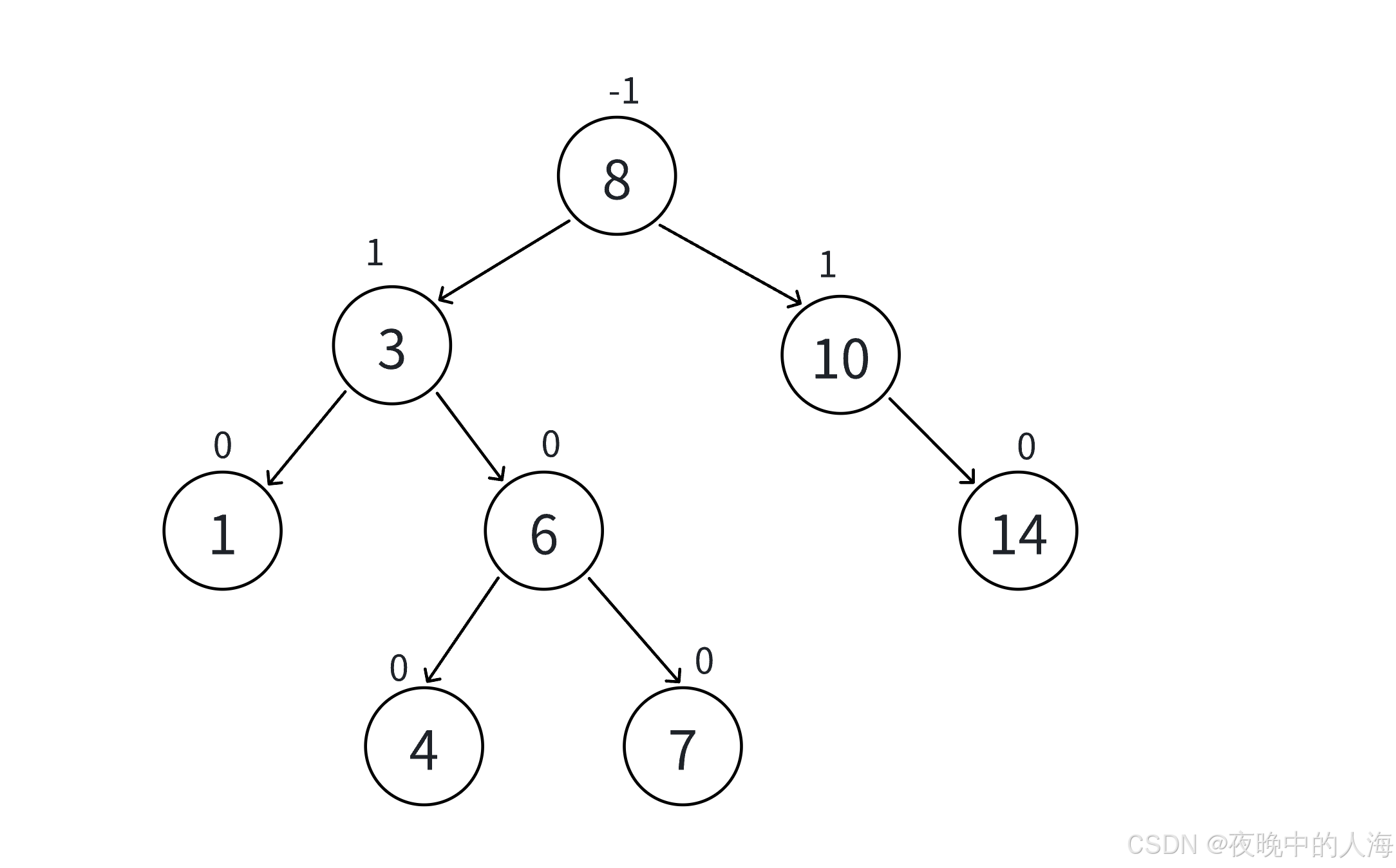
二、AVL树的性质
AVL树主要有三大性质:
1.每棵树的左右子树都是AVL树。
2.左子树和右子树的高度之差的绝对值不超过1。
3.每个节点都会有一个平衡因子,且任何一个节点的平衡因子都为1、0、-1。
三、AVL树的实现
1. 树的基本结构
AVL树的结点包含了左右节点的指针以及父亲节点的指针,同时还有有key、value以及代表树平衡的平衡因子。
1 2 3 4 5 6 7 8 9 10 11 12 13 14 15 16 17 | template<class K, class V>struct AVLTreeNode{ pair<K, V> _kv; AVLTreeNode<K, V>* _left; AVLTreeNode<K, V>* _right; AVLTreeNode<K, V>* _parent; //平衡因子 int _bf; AVLTreeNode(const pair<K, V>& kv) :_kv(kv) , _left(nullptr) , _right(nullptr) , _parent(nullptr) , _bf(0) {}}; |
2. 树的插入
树的插入按照搜索二叉树的规则进行插入。插入节点后更新平衡因子,如果没有违反规则(即没有导致节点的平衡因子变成2/-2),则插入结束;如果违反规则,则树会不平衡,需要进行旋转操作。
平衡因子的更新规则:
1.平衡因子 = 右子树高度 - 左子树高度。
2.只有子树高度的变化才会影响当前节点的平衡因子。
3.插入节点后会增加数的高度,若新增节点在parent的右子树,则parent的平衡因子++,相反在parent的左子树时,则平衡因子- -。
每更新完一个节点的平衡因子都需要进行以下判断:
1.如果parent的平衡因子等于1/-1时,说明parent原先的平衡因子为0,插入节点后左子树或右子树的高度增加了,说明还需要向上更新平衡因子。
2.如果parent的平衡因子等于0,说明parent原先的平衡因子为1/-1,插入节点后左右两棵子树从不平衡变平衡了,说明无需更新平衡因子。
3.如果parent的平衡因子等于2/-2时,说明parent原先的平衡因子等于1/-1,插入节点后插入到了较高的那一棵子树,说明此时以parent为根节点的子树已经不平衡了,需要进行旋转处理。
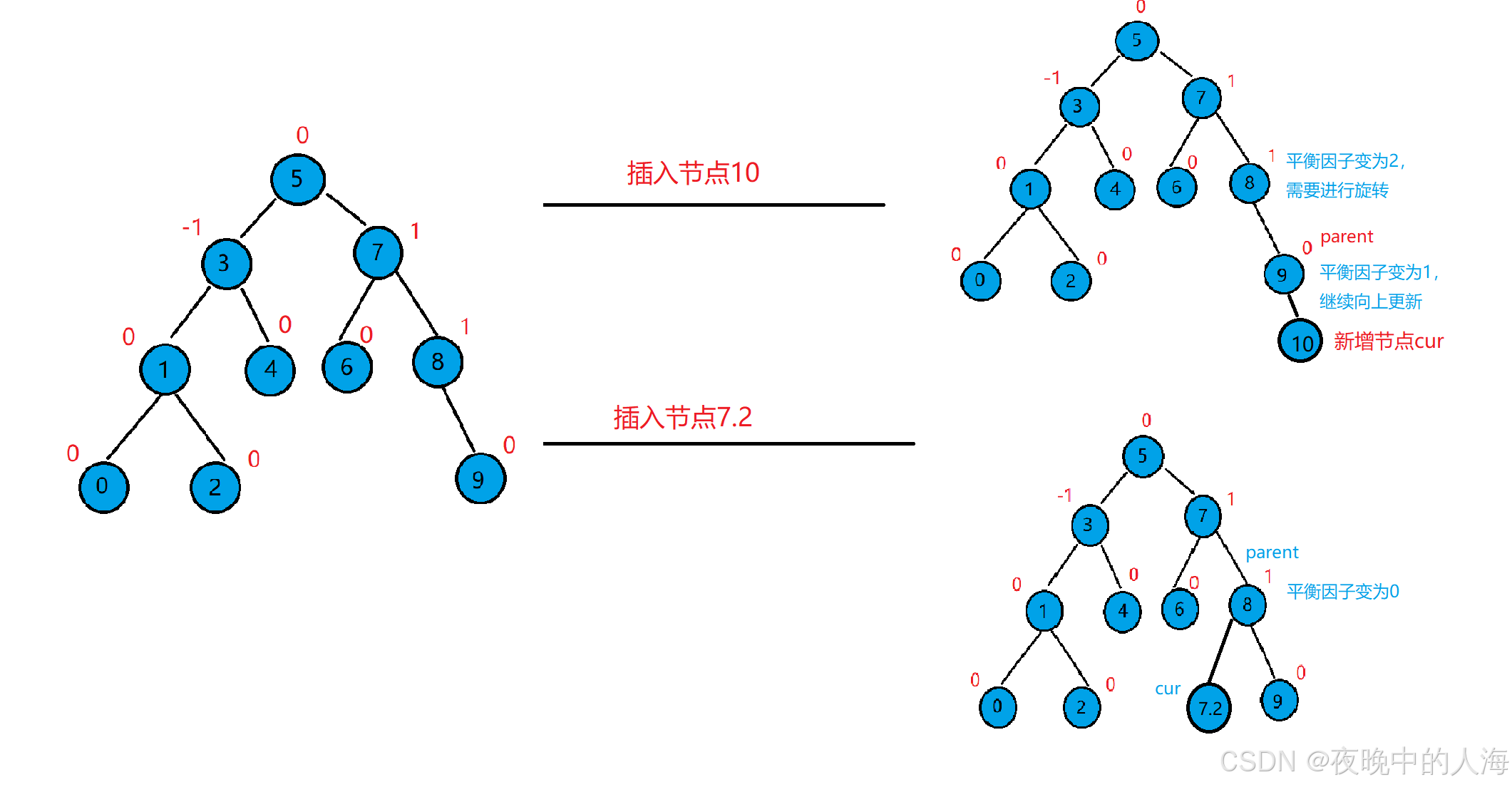
1 2 3 4 5 6 7 8 9 10 11 12 13 14 15 16 17 18 19 20 21 22 23 24 25 26 27 28 29 30 31 32 33 34 35 36 37 38 39 40 41 42 43 44 45 46 47 48 49 50 51 52 53 54 55 56 57 58 59 60 61 62 63 64 65 66 67 68 69 70 71 72 73 74 75 76 77 78 79 80 81 82 83 84 85 86 87 88 | bool Insert(const pair<K, V>& kv){ //如果树为空,则插入的节点就是根节点 if (_root == nullptr) { _root = new Node(kv); return true; } Node* parent = nullptr; Node* cur = _root; while (cur) { if (cur->_kv.first < kv.first) { parent = cur; cur = cur->_right; } else if (cur->_kv.first > kv.first) { parent = cur; cur = cur->_left; } else { return false; } } cur = new Node(kv); if (parent->_kv.first < kv.first) { parent->_right = cur; } else { parent->_left = cur; } cur->_parent = parent; //更新平衡因子 while (parent) { if (cur == parent->_left) { parent->_bf--; } else parent->_bf++; if (parent->_bf == 0) { break; } else if (parent->_bf == 1 || parent->_bf == -1) { //继续往上进行更新 cur = parent; parent = parent->_parent; } else if (parent->_bf == 2 || parent->_bf == -2) { //不平衡,旋转处理 if (parent->_bf == -2 && cur->_bf == -1) { RotateR(parent); } else if(parent->_bf == 2 && cur->_bf == 1) { RotateL(parent); } else if (parent->_bf == -2 && cur->_bf == 1) { RotateLR(parent); } else if (parent->_bf == 2 && cur->_bf == -1) { RotateRL(parent); } else { assert(false); } } else { assert(false); } break; } return true;} |
3. 树的旋转
旋转的目的就是让树从失衡到平衡,降低树的高度。旋转主要分为四种,分别为左单旋、右单旋、左右双旋和右左双旋。下面我们具体讲讲每一种旋转的内部逻辑。
• 左单旋
条件:新节点插入到子树较高的右侧。
我们用图来感受一下其旋转的过程:
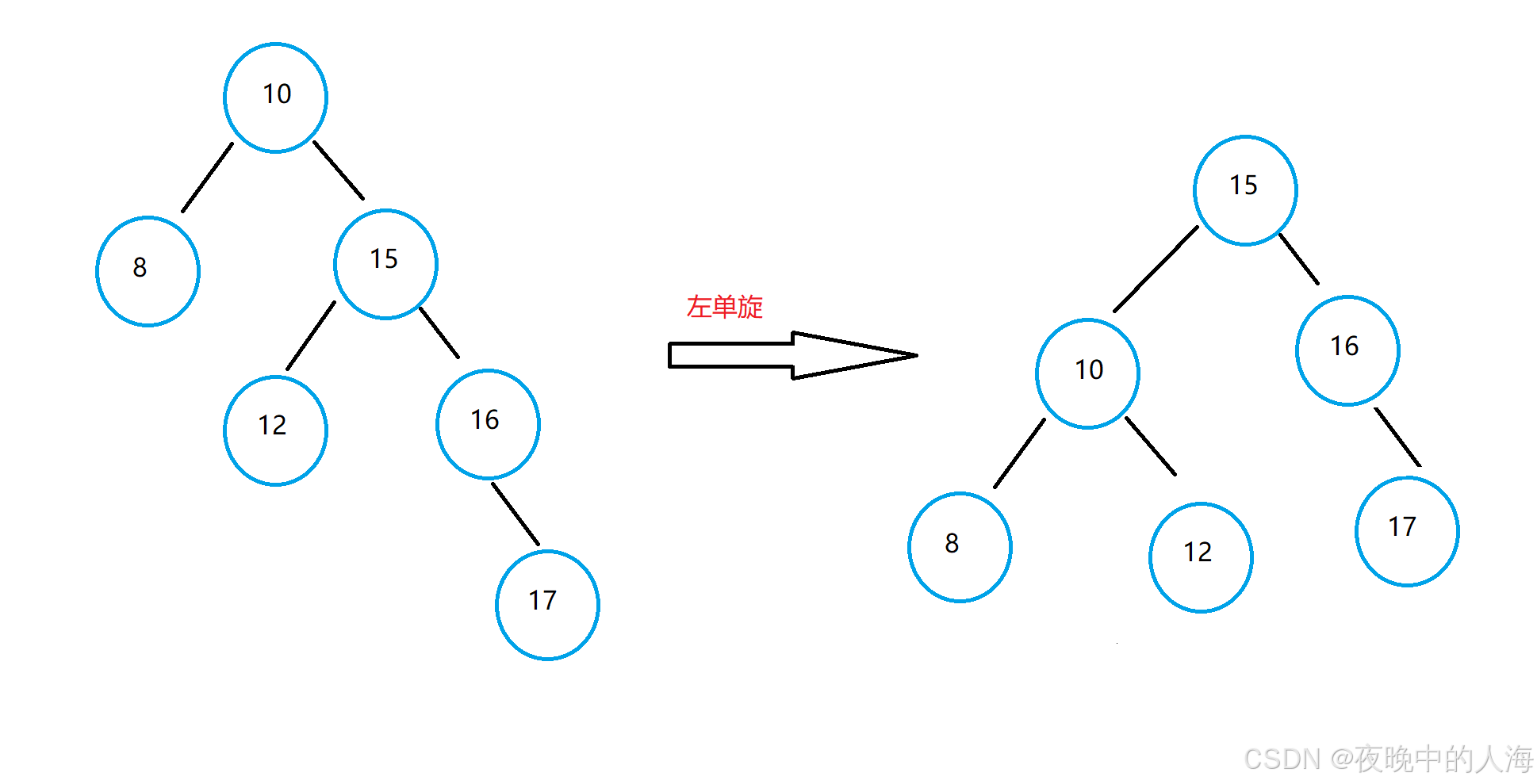
1.先将15的左子树的节点12变成10的右子树。
2.再将10变成15的左子树,15成为新树的根节点。
3.更新平衡因子
由于左单旋的情况很多,我们也可以用一张抽象图来表示:

代码所示:
1 2 3 4 5 6 7 8 9 10 11 12 13 14 15 16 17 18 19 20 21 22 23 24 25 26 27 28 | //左单旋void RotateL(Node* parent){ Node* subR = parent->_right; Node* subRL = subR->_left; parent->_right = subR; if (subRL) subRL->_parent = parent; Node* pparent = parent->_parent; if (pparent == nullptr) { _root = subR; subR->_parent = nullptr; } else { if (pparent == parent->_right) { parent->_right = subR; } else { parent->_left = subR; } subR->_parent = pparent; } parent->_bf = subR->_bf = 0;} |
• 右单旋
条件:新节点插入到子树较高的左侧
用图来感受旋转的过程:
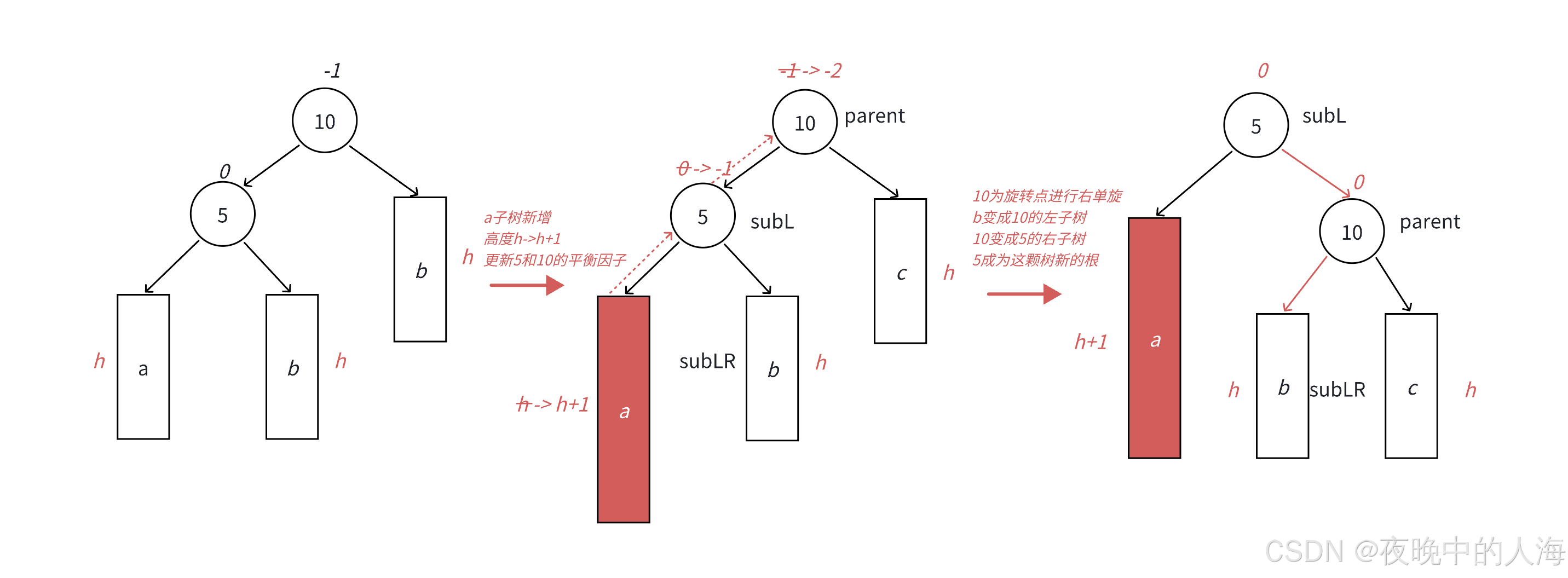
我们会发现和左单旋和相似
1.先将5的右子树的值b变成10的左子树。
2.再将10变成5的右子树,旋转完后5成为整棵树的根节点。
3.更新平衡因子。
代码所示:
1 2 3 4 5 6 7 8 9 10 11 12 13 14 15 16 17 18 19 20 21 22 23 24 25 26 27 28 29 30 | //右单旋void RotateR(Node* parent){ Node* subL = parent->_left; Node* subLR = subL->_right; parent->_left = subLR; if(subLR) subLR->_parent = parent; Node* pparent = parent->_parent; subL->_right = parent; parent->_parent = subL; if (pparent == nullptr) { _root = subL; subL->_parent = nullptr; } else { if (pparent == parent->_left) { parent->_left = subL; } else { parent->_right = subL; } subL->_parent = pparent; } parent->_bf = subL->_bf = 0;} |
• 左右双旋
条件:新节点插入到较高左子树的右侧。
下面我们用图来演示一下其旋转过程:
1.插入新节点
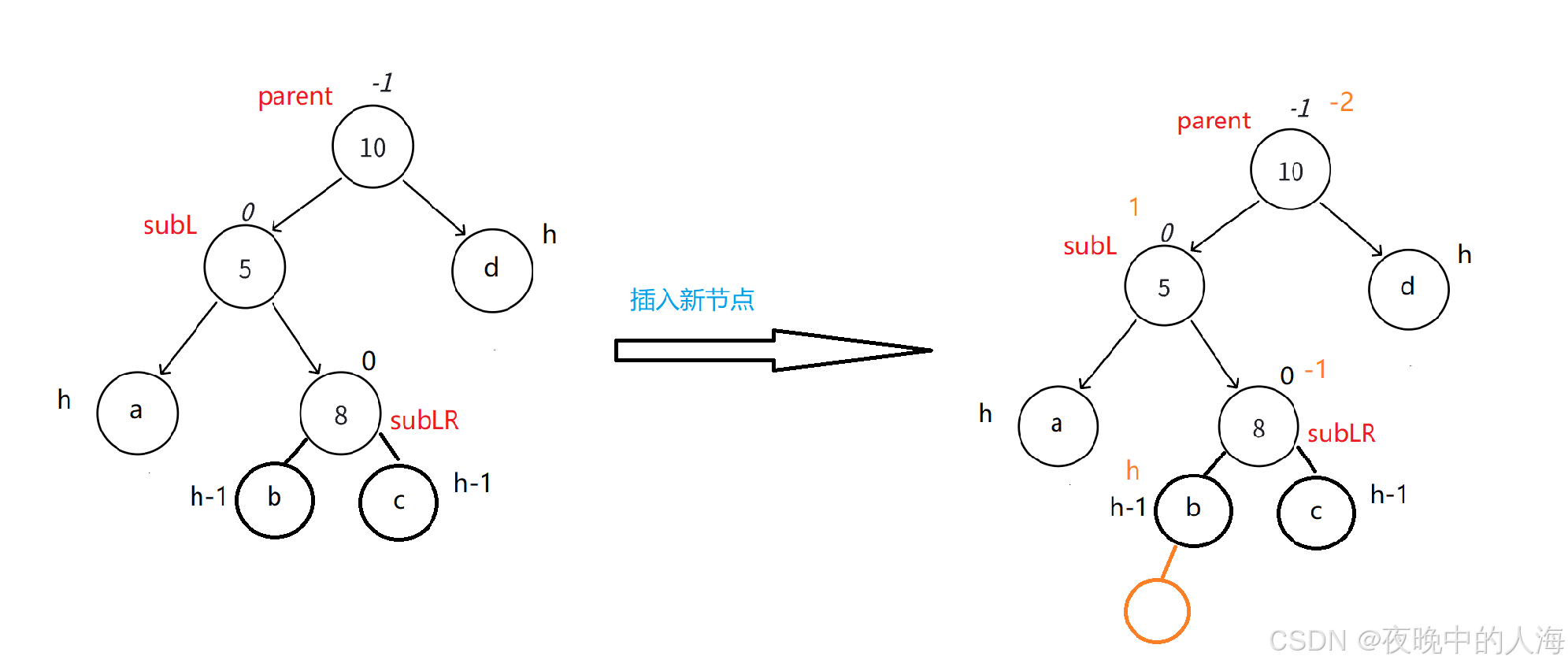
2.以节点5为旋转点进行左单旋
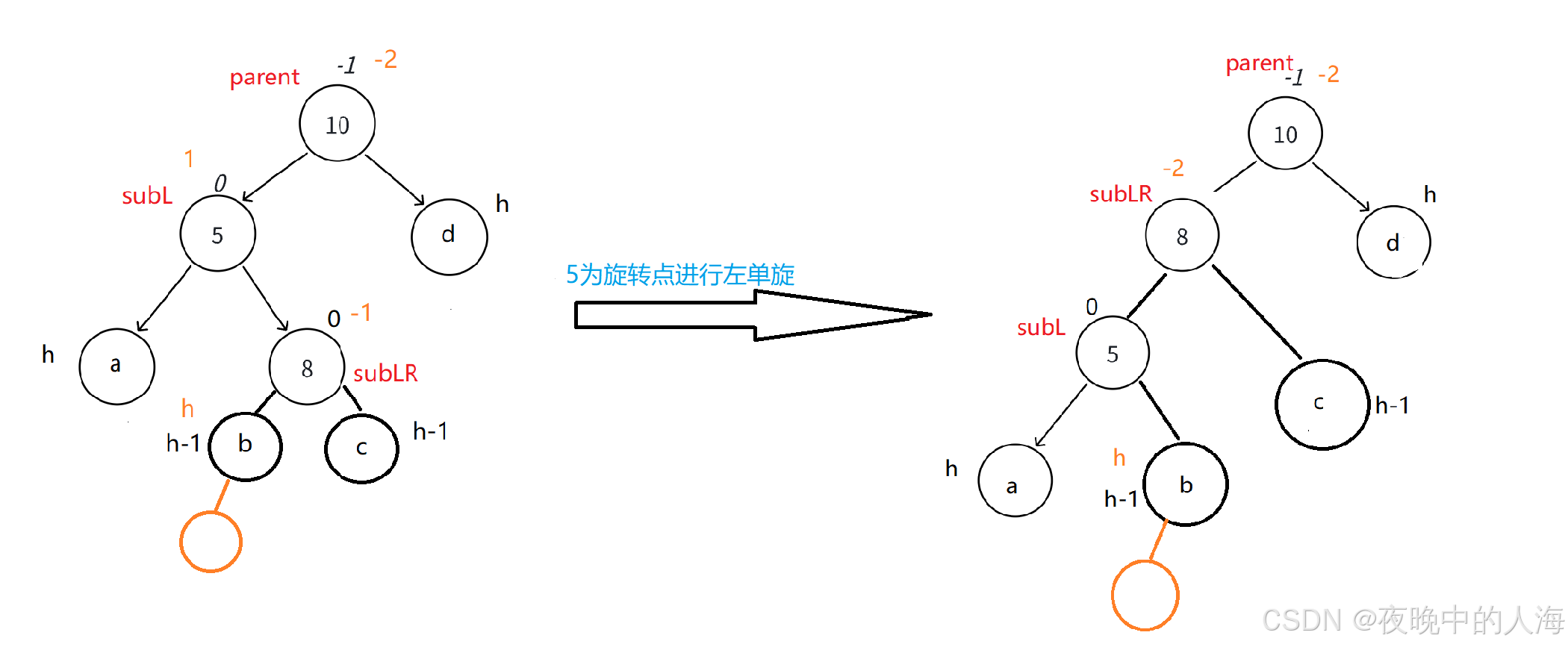
3.以节点为10进行右单旋
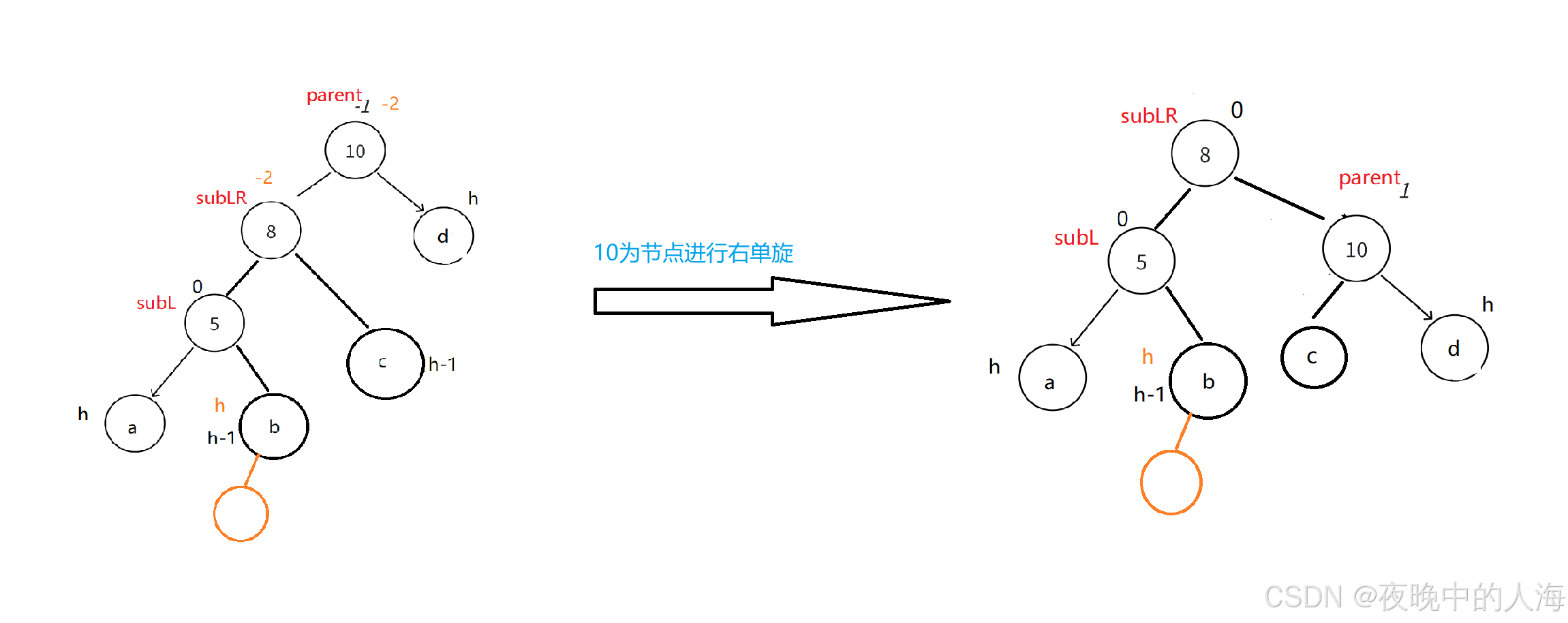
4.旋转完后更新平衡因子。
平衡因子又分为三种情况:
1.当subLR的平衡因子为-1时,左右双旋后parent、subL,subLR的平衡因子分别为1、0、0。
2.当subLR的平衡因子为1时,左右双旋后parent、subL,subLR的平衡因子分别为0、-1、0。
3.当subLR的平衡因子为0时,左右双旋后parent、subL,subLR的平衡因子分别为0、0、0。
代码所示:
1 2 3 4 5 6 7 8 9 10 11 12 13 14 15 16 17 18 19 20 21 22 23 24 25 26 27 28 29 30 31 | //左右双旋void RotateLR(Node* parent){ Node* subL = parent->_left; Node* subLR = subL->_right; int bf = subLR->_bf; RotateL(parent->_left); RotateR(parent); if (bf == -1) { subLR->_bf = 0; subL->_bf = 0; parent->_bf = 1; } else if (bf == 1) { subLR->_bf = 0; subL->_bf = -1; parent->_bf = 0; } else if (bf == 0) { subLR->_bf = 0; subL->_bf = 0; parent->_bf = 0; } else { assert(false); }} |
• 右左双旋
条件:插入到较高右子树的左侧
其旋转过程和左右双旋类似,这就不一一列举了。
旋转完过后也是需要更新平衡因子,平衡因子也是跟左右双旋一样有三种情况。
代码所示:
1 2 3 4 5 6 7 8 9 10 11 12 13 14 15 16 17 18 19 20 21 22 23 24 25 26 27 28 29 30 31 | //右左双旋void RotateRL(Node* parent){ Node* subR = parent->_right; Node* subRL = subR->_left; int bf = subRL->_bf; RotateR(parent); RotateL(parent); if (bf == 0) { subR->_bf = 0; subRL->_bf = 0; parent->_bf = 0; } else if (bf == 1) { subR->_bf = 0; subRL->_bf = 0; parent->_bf = -1; } else if (bf == -1) { subR->_bf = 1; subRL->_bf = 0; parent->_bf = 0; } else { assert(false); }} |
四、AVL树的其它功能
1. 树的查找
定义一个cur指针从树的根节点开始查找,按一下规则进行查找:
1.当key的值小于当前节点的值时,则在该节点的左边进行查找。
2.当key的值大于当前节点的值时,则在该节点的右边进行查找。
3.若key的值等于当前节点的值时,则说明查找成功,返回true。
4.若遍历完还没查找到该节点的值,则说明没有此节点,返回false。
代码所示:
1 2 3 4 5 6 7 8 9 10 11 12 13 14 15 16 17 18 19 20 | Node* Find(const K& key){ Node* cur = _root; while (cur) { if (cur->_kv.first < key) { cur = cur->_right; } else if (cur->_kv.first > key) { cur = cur->_left; } else { return cur; } } return nullptr;} |
2. 树的遍历
我们遍历方式有前序、中序、后序、层序等方式,我们在这就采用中序遍历的方式来遍历树的每一节点。
代码所示:
1 2 3 4 5 6 7 8 9 10 | void _Inorder(Node* root){ if (root == nullptr) { return; } _Inorder(root->_left); cout << root->_kv.first << ":" << root->_kv.second << endl; _Inorder(root->_right);} |
3. 树的高度
1 2 3 4 5 6 7 8 9 10 | int _Height(Node* root){ if (root == nullptr) { return; } int leftHeight = _Height(root->_left); int rightHeight = _Height(root->_right); return leftHeight > rightHeight ? leftHeight + 1 : rightHeight + 1;} |
4. 树的大小
返回左子树+右子树再加上根节点即可。
1 2 3 4 5 6 7 8 | int _Size(Node* root){ if (root == nullptr) { return; } return _Size(root->_left) + _Size(root->_right) + 1;} |
五、总结
1. AVL树的优缺点
优点:
**1.查找效率高:**由于AVL树总是保持平衡,其高度相对较低,因此查找操作的时间复杂度为O(log2N),效率较高。
2.结构稳定: AVL树的平衡性使得其结构相对稳定,不会出现极端不平衡的情况,从而保证了操作的稳定性和可靠性。
缺点:
1.插入和删除复杂: AVL树在插入和删除节点时,可能需要通过旋转操作来保持树的平衡,比较复杂。
2.可能导致性能下降: 在频繁插入和删除的场景下,AVL树需要不断地进行旋转操作来保持平衡,这就有可能导致性能降低。
2. 完整代码
1 2 3 4 5 6 7 8 9 10 11 12 13 14 15 16 17 18 19 20 21 22 23 24 25 26 27 28 29 30 31 32 33 34 35 36 37 38 39 40 41 42 43 44 45 46 47 48 49 50 51 52 53 54 55 56 57 58 59 60 61 62 63 64 65 66 67 68 69 70 71 72 73 74 75 76 77 78 79 80 81 82 83 84 85 86 87 88 89 90 91 92 93 94 95 96 97 98 99 100 101 102 103 104 105 106 107 108 109 110 111 112 113 114 115 116 117 118 119 120 121 122 123 124 125 126 127 128 129 130 131 132 133 134 135 136 137 138 139 140 141 142 143 144 145 146 147 148 149 150 151 152 153 154 155 156 157 158 159 160 161 162 163 164 165 166 167 168 169 170 171 172 173 174 175 176 177 178 179 180 181 182 183 184 185 186 187 188 189 190 191 192 193 194 195 196 197 198 199 200 201 202 203 204 205 206 207 208 209 210 211 212 213 214 215 216 217 218 219 220 221 222 223 224 225 226 227 228 229 230 231 232 233 234 235 236 237 238 239 240 241 242 243 244 245 246 247 248 249 250 251 252 253 254 255 256 257 258 259 260 261 262 263 264 265 266 267 268 269 270 271 272 273 274 275 276 277 278 279 280 281 282 283 284 285 286 287 288 289 290 291 292 293 294 295 296 297 298 299 300 301 302 303 304 305 306 307 308 309 310 311 | #include<iostream>#include<assert.h>using namespace std;template<class K, class V>struct AVLTreeNode{ // 需要parent指针,后续更新平衡因子可以看到 pair<K, V> _kv; AVLTreeNode<K, V>* _left; AVLTreeNode<K, V>* _right; AVLTreeNode<K, V>* _parent; //平衡因子 int _bf; // balance factor AVLTreeNode(const pair<K, V>& kv) :_kv(kv) , _left(nullptr) , _right(nullptr) , _parent(nullptr) , _bf(0) {}};template<class K,class V>class AVLTree{ typedef AVLTreeNode<K, V> Node;public: bool Insert(const pair<K, V>& kv) { if (_root == nullptr) { _root = new Node(kv); return true; } Node* parent = nullptr; Node* cur = _root; while (cur) { if (cur->_kv.first < kv.first) { parent = cur; cur = cur->_right; } else if (cur->_kv.first > kv.first) { parent = cur; cur = cur->_left; } else { return false; } } cur = new Node(kv); if (parent->_kv.first < kv.first) { parent->_right = cur; } else { parent->_left = cur; } cur->_parent = parent; //更新平衡因子 while (parent) { if (cur == parent->_left) { parent->_bf--; } else parent->_bf++; if (parent->_bf == 0) { break; } else if (parent->_bf == 1 || parent->_bf == -1) { //继续往上进行更新 cur = parent; parent = parent->_parent; } else if (parent->_bf == 2 || parent->_bf == -2) { //不平衡,旋转处理 if (parent->_bf == -2 && cur->_bf == -1) { RotateR(parent); } else if(parent->_bf == 2 && cur->_bf == 1) { RotateL(parent); } else if (parent->_bf == -2 && cur->_bf == 1) { RotateLR(parent); } else if (parent->_bf == 2 && cur->_bf == -1) { RotateRL(parent); } else { assert(false); } } else { assert(false); } break; } return true; } //右单旋 void RotateR(Node* parent) { Node* subL = parent->_left; Node* subLR = subL->_right; parent->_left = subLR; if(subLR) subLR->_parent = parent; Node* pparent = parent->_parent; subL->_right = parent; parent->_parent = subL; if (pparent == nullptr) { _root = subL; subL->_parent = nullptr; } else { if (pparent == parent->_left) { parent->_left = subL; } else { parent->_right = subL; } subL->_parent = pparent; } parent->_bf = subL->_bf = 0; } //左单旋 void RotateL(Node* parent) { Node* subR = parent->_right; Node* subRL = subR->_left; parent->_right = subR; if (subRL) subRL->_parent = parent; Node* pparent = parent->_parent; if (pparent == nullptr) { _root = subR; subR->_parent = nullptr; } else { if (pparent == parent->_right) { parent->_right = subR; } else { parent->_left = subR; } subR->_parent = pparent; } parent->_bf = subR->_bf = 0; } //左右双旋 void RotateLR(Node* parent) { Node* subL = parent->_left; Node* subLR = subL->_right; int bf = subLR->_bf; RotateL(parent->_left); RotateR(parent); if (bf == -1) { subLR->_bf = 0; subL->_bf = 0; parent->_bf = 1; } else if (bf == 1) { subLR->_bf = 0; subL->_bf = -1; parent->_bf = 0; } else if (bf == 0) { subLR->_bf = 0; subL->_bf = 0; parent->_bf = 0; } else { assert(false); } } //右左双旋 void RotateRL(Node* parent) { Node* subR = parent->_right; Node* subRL = subR->_left; int bf = subRL->_bf; RotateR(parent); RotateL(parent); if (bf == 0) { subR->_bf = 0; subRL->_bf = 0; parent->_bf = 0; } else if (bf == 1) { subR->_bf = 0; subRL->_bf = 0; parent->_bf = -1; } else if (bf == -1) { subR->_bf = 1; subRL->_bf = 0; parent->_bf = 0; } else { assert(false); } } void Inorder() { _Inorder(_root); cout << endl; } void Hight() { return _Hight(_root); } void Size() { return _Size(_root); }private: void _Inorder(Node* root) { if (root == nullptr) { return; } _Inorder(root->_left); cout << root->_kv.first << ":" << root->_kv.second << endl; _Inorder(root->_right); } int _Height(Node* root) { if (root == nullptr) { return; } int leftHeight = _Height(root->_left); int rightHeight = _Height(root->_right); return leftHeight > rightHeight ? leftHeight + 1 : rightHeight + 1; } int _Size(Node* root) { if (root == nullptr) { return; } return _Size(root->_left) + _Size(root->_right) + 1; } Node* Find(const K& key) { Node* cur = _root; while (cur) { if (cur->_kv.first < key) { cur = cur->_right; } else if (cur->_kv.first > key) { cur = cur->_left; } else { return cur; } } return nullptr; }private: Node* _root = nullptr;}; |
总结
到此这篇关于C++中AVL树的底层以及实现方法总结的文章就介绍到这了,更多相关C++ AVL树底层及实现内容请搜索脚本之家以前的文章或继续浏览下面的相关文章希望大家以后多多支持脚本之家!


.png)
.png)
.png)
.png)
.png)
.png)
.png)
.png)
.png)
.png)
.png)
.png)



最新评论